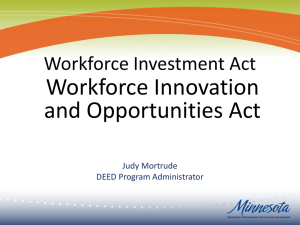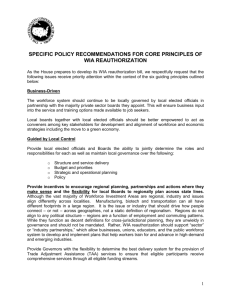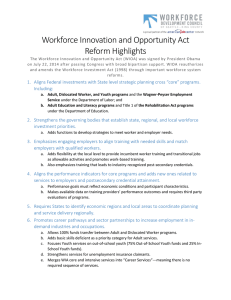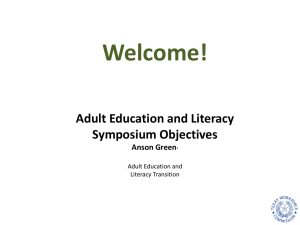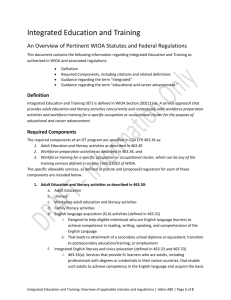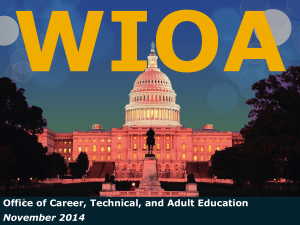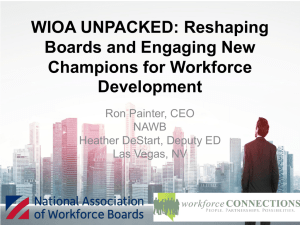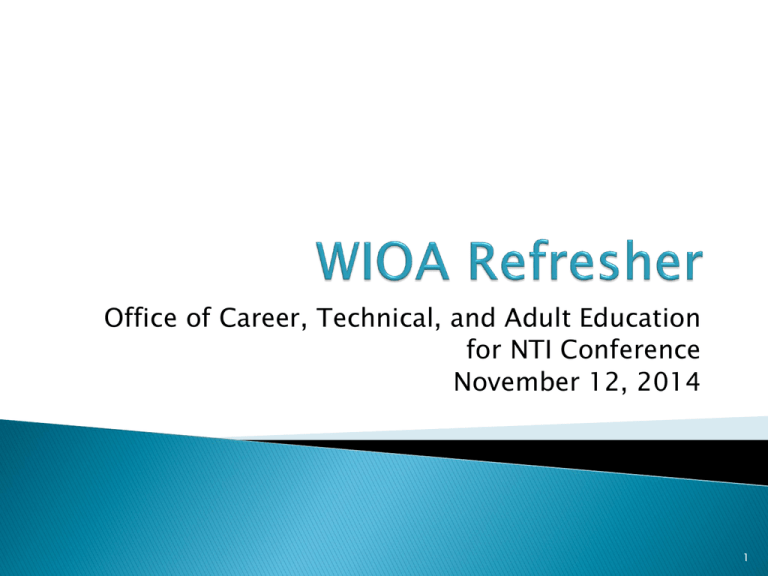
Office of Career, Technical, and Adult Education
for NTI Conference
November 12, 2014
1
•Unified strategic planning across core programs
Program
Alignment
•Enhances role of State and Local Workforce Development Boards in
developing and implementing a Unified State Plan
•Establishment of common measures across core programs
Increased
Accountability
Enhanced
Service Delivery
•Increases accountability and transparency through reporting and
evaluations
•Promotes engagement of employers and alignment of education and
training activities through career pathways
•Strengthens partnerships and investments in one-stop delivery system
2
Title I – Workforce Development Activities
◦ Subtitle A: System Alignment
◦ Subtitle B: Workforce Activities and Providers
Title II – Adult Education and Literacy
Title III – Amendments to the Wagner-Peyser Act
Title IV – Amendments to the Rehabilitation Act of
1973
Title V – General Provisions
3
Individual with Barriers to Employment
Career Pathway
One-Stop Partner
Supportive Services
Workforce Development System
4
Individual with a barrier to employment
A member of one or more of the following populations:
Displaced homemakers
Ex-offenders
Long-term unemployed
Low-income individuals
Homeless individuals,
or homeless children
and youth
Individuals within 2
years of exhausting
lifetime eligibility under
the SSA, title IV part A
Indians, Alaska Natives,
and Native Hawaiians
Youth who are in or
have aged out of foster
care
Single parents
(including single
pregnant women)
Individuals with
disabilities, including
youth
English language
learners, individuals
with low levels of
literacy, and individuals
facing substantial
cultural barriers
Such other groups as
the Governor
determines to have
barriers to employment
Older individuals
Migrant and seasonal
farmworkers
5
Career Pathway
A combination of rigorous and high-quality education, training, and
other services that-Aligns with skill needs of industries in
the State and regional economy
Organizes education, training, and
other services to meet the particular
needs of an individual to accelerate
educational and career advancement
Prepares individual to be successful in
secondary or postsecondary education
options, including registered
apprenticeship
Enables an individual to attain a
secondary school diploma or its
recognized equivalent, and at least 1
recognized postsecondary credential
Includes counseling to support in
achieving the individual’s education
and career goals
Helps an individual enter or advance
within a specific occupation or
occupational cluster
Includes education offered
concurrently with workforce
preparation activities and training for
a specific occupation or occupational
cluster
6
States required to submit a single, strategic, coordinated
plan
Changes in State Plan Requirements
WIA
WIOA
5-year State plan
4-year State plan
Unified State Plans
Unified State Plans
Strategic planning
elements
Strategic and operational
planning elements
Plan submitted to ED
Secretary
Submitted to DOL
Secretary, joint approval
with ED
optional
required
7
AEFLA
Plan
Elements
Alignment of adult education content
standards with ESEA State academic standards
Funding of local activities using 13
considerations under AEFLA
Use of funds for adult education and literacy
activities
Assess and improve quality of adult education
providers
8
Submission Dates
• Plans submitted March 2016
• May be modified at end of first 2-year
period
• Subsequent plans submitted 120 days
prior to end of 4-year period
Early Implementers
•Departments must establish process
for approving early unified plans
9
Combined State plan incorporates other key
partners (including Perkins, TANF)
Plans must include:
o Strategy for joint planning and coordination
o Assurance allowing core programs to review
plan
Plan approval within 90 days (or 120 days if 3 or
more Secretaries)
Special rule for CTE regarding performance
10
Streamlined Membership
o
o
o
o
Reduces size of State Workforce Development
Boards
Includes business majority, labor organizations,
apprenticeship (new), organizations serving
individuals with barriers to employment
Includes the lead State official with the
responsibility for the core programs
No representation in multiple categories
11
Develop and implement State Plan
Align core programs and develop and
improve of workforce system
◦ Develop career pathways
◦ Develop and implement one-stops
◦ Identify regions and local areas
Establish State performance measures and
targets to assess effectiveness of core
programs
12
Develop policies to coordinate services
◦ Criteria and procedures for local board to use in
assessing core programs
◦ Guidance on infrastructure costs
◦ Defining role and contributions of one-stop partners,
including equitable and efficient cost allocation
Align technology and data systems across one-stop
partners
Technological improvements for digital literacy,
accelerating learning, accessibility, and professional
development
13
Section 107 and 108 – Expands role and responsibilities of
local workforce development boards, including the
development of local plan and alignment of AEFLA provider
activities with the local plan.
Section 116 – Replaces Section 212 of WIA. Establishes
common performance accountability indicators that apply
across the four core programs
Section 121 – Strengthens the roles and responsibilities of
partner programs in the one-stop delivery system, including
contributions to infrastructure costs and access to partner
activities
Promotes coordination on a variety of evaluation activities
to promote program improvement
14
Create a partnership among Federal
Government, States, and localities to provide
adult education and literacy services that
Assist adults to become literate and obtain the
knowledge and skills necessary for employment and
economic self-sufficiency
Assist adults who are parents or family members
become a full partner in the education development
of their children
Assist adults in completing high school
15
Purpose expanded to:
Promote transitions from adult education to
postsecondary education and training through
career pathways
Assist immigrants and English language learners
improve reading, writing, math, speaking, and
comprehending the English language
acquire understanding of American government,
individual freedom, and responsibilities of
citizenship
16
WIOA maintains much of the State fiscal requirements
State Distribution of Funds
State administrative expenses capped at 5%
or $85,000 (increased from $65,000 under
WIA)
State leadership may not exceed 12.5%
Maintains 82.5% for grants and contracts to
eligible providers, not more than 20% may be
used for corrections education programs
(increased from 10%)
Match and MOE requirements remain
unchanged
17
Changes “eligible provider” definition
Creates three new activities supported with AEFLA funds
Increases the amount of funds reserved for national
leadership activities (from $8 million to $15 million) and
includes four new required activities
Adds four new required activities to be supported with State
leadership funds, along with several permissible activities
Revises considerations States must use in awarding grants
to eligible providers
18




